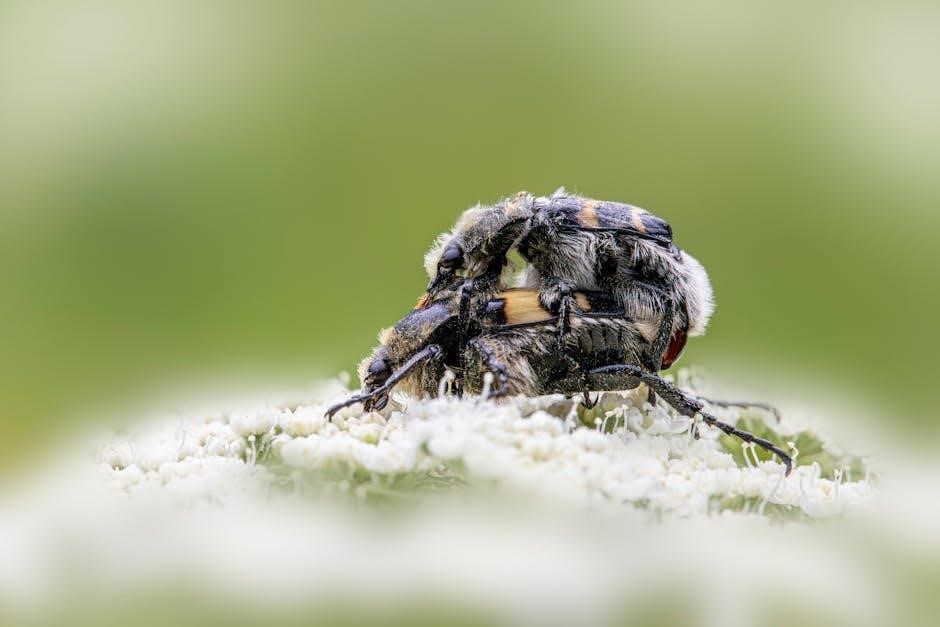Unit 2 of AP Biology explores the fundamental processes of cellular respiration and photosynthesis, essential for understanding energy transfer in living organisms. This unit is crucial for grasping how cells generate energy and sustain life, forming a cornerstone of biological systems and their practical applications in agriculture and biotechnology.

1.1. Overview of Unit 2
Unit 2 of AP Biology delves into the intricate mechanisms of cellular energy production, focusing on cellular respiration and photosynthesis. These processes are vital for life, enabling cells to harness and convert energy. Cellular respiration, including aerobic and anaerobic pathways, highlights how cells break down glucose to produce ATP, while photosynthesis explores how plants, algae, and some bacteria synthesize glucose using sunlight. The unit emphasizes the stages of glycolysis, the Krebs cycle, and the electron transport chain, as well as the light-dependent and light-independent reactions in photosynthesis. Key concepts include the roles of ATP, NADH, and chlorophyll, along with the environmental factors influencing these processes. Understanding these biological pathways is essential for grasping how organisms maintain life and respond to their environments. This unit also lays the foundation for exploring practical applications in agriculture, biotechnology, and environmental science, making it a critical component of the AP Biology curriculum.
1.2. Importance of Energy in Biological Systems
Energy is the driving force behind all biological processes, enabling cells to function, grow, and maintain life. It fuels essential activities such as DNA replication, protein synthesis, and cell division. ATP, the primary energy currency of the cell, plays a central role in transferring energy rapidly and efficiently. Without energy, cells cannot transport nutrients, regulate ions, or respond to stimuli. Biological systems rely on the continuous production and utilization of energy to sustain homeostasis and support complex functions. The transformations of energy, whether through cellular respiration or photosynthesis, are fundamental to life. Understanding energy flow and its applications is critical for grasping how organisms interact with their environments and how life persists across generations. This foundation is vital for exploring advanced topics in ecology, evolution, and biotechnology, making energy a cornerstone of biological studies.
1.3. Key Concepts and Themes
Unit 2 of AP Biology revolves around key concepts that underpin the flow of energy in living systems. Central themes include energy transformation, metabolic pathways, and the regulation of processes that sustain life. Understanding ATP as the energy currency of the cell is crucial, alongside the roles of enzymes in catalyzing reactions. The structure and function of cellular components, such as mitochondria and chloroplasts, are emphasized. Key concepts also include the distinction between aerobic and anaerobic respiration, the light-dependent and light-independent reactions of photosynthesis, and the efficiency of energy conversion. Additionally, the unit explores how environmental factors influence metabolic processes and the interplay between energy production and ecological systems. These themes provide a foundation for analyzing how organisms adapt, grow, and interact with their surroundings. Mastery of these concepts is essential for understanding the intricate balance of energy flow in biological systems and its broader implications in biology.

Cellular Respiration
Cellular respiration is the process by which cells break down glucose to produce ATP, the energy currency of the cell. This metabolic pathway is essential for sustaining life and powering cellular functions. It involves the breakdown of organic molecules to release energy, which is then stored in ATP through a series of reactions. Cellular respiration is a critical mechanism for converting biochemical energy into a usable form, enabling cells to perform various activities. Understanding this process is fundamental to grasping how cells maintain energy homeostasis and respond to environmental demands.
Cellular respiration is a vital biological process that converts glucose and other organic molecules into energy in the form of ATP. This essential metabolic function occurs in all living organisms, from bacteria to complex eukaryotes. It is a catabolic process that breaks down molecules to release energy, which is then stored in ATP for cellular use. Cellular respiration can occur with or without oxygen, leading to aerobic and anaerobic pathways. Aerobic respiration is more efficient and produces significantly more ATP, while anaerobic respiration is less efficient but allows cells to survive in low-oxygen environments. The process involves a series of enzyme-catalyzed reactions that take place in the cytoplasm and mitochondria of eukaryotic cells. Understanding cellular respiration is fundamental to grasping how cells generate energy, maintain homeostasis, and support life. This process is also critical for understanding broader biological concepts, such as energy flow in ecosystems and the carbon cycle.
2.2. Aerobic vs. Anaerobic Respiration
Aerobic and anaerobic respiration are two distinct pathways by which cells generate energy from glucose. Aerobic respiration requires oxygen and is a highly efficient process, producing 36-38 ATP molecules per glucose molecule. It occurs in three stages: glycolysis, the Krebs cycle, and the electron transport chain. Anaerobic respiration, in contrast, does not require oxygen and is less efficient, yielding only 2 ATP per glucose molecule. This process is typically used by organisms in environments with limited oxygen availability. Key differences include the presence of oxygen, the number of ATP produced, and the complexity of the pathways. Aerobic respiration is more common in eukaryotic cells, while anaerobic respiration is often seen in prokaryotes and during high-intensity, short-duration activities in humans. Understanding these differences is crucial for comprehending cellular energy production and the adaptations of various organisms to their environments.
2.3. Stages of Cellular Respiration
Cellular respiration is a multi-step process divided into three main stages: glycolysis, the Krebs cycle, and the electron transport chain (ETC). Glycolysis occurs in the cytosol and does not require oxygen, breaking down glucose into two pyruvate molecules while producing 2 ATP and NADH. In the presence of oxygen, pyruvate enters the mitochondria for the Krebs cycle, where it is further broken down into acetyl-CoA, producing additional ATP, NADH, and FADH2. The Krebs cycle is a critical source of high-energy electron carriers. Finally, the ETC, located in the inner mitochondrial membrane, uses these electron carriers to pump protons across the membrane, creating a proton gradient. This gradient drives ATP synthase to produce the majority of ATP through oxidative phosphorylation. Together, these stages efficiently convert glucose into ATP, with aerobic respiration yielding 36-38 ATP molecules per glucose molecule.
2.4. Electron Transport Chain and ATP Production
The electron transport chain (ETC) is a series of protein complexes located in the inner mitochondrial membrane. It is driven by the proton gradient established during the Krebs cycle. Electrons from NADH and FADH2 are passed through the ETC, which pumps protons across the membrane, further increasing the gradient. This process is accompanied by the release of energy, which is used to produce ATP through oxidative phosphorylation. The protons flow back across the membrane through ATP synthase, driving the synthesis of ATP from ADP and inorganic phosphate. The ETC produces the majority of ATP in cellular respiration, with approximately 32-34 ATP molecules generated from NADH and 2 ATP from FADH2. Oxygen acts as the final electron acceptor, reducing the risk of electron leakage and enabling the ETC to function efficiently. This process underscores the critical role of the ETC in energy production, making it a cornerstone of cellular respiration.
2.5. Factors Affecting Cellular Respiration
Various factors influence the rate and efficiency of cellular respiration. Oxygen availability is a critical determinant, as aerobic respiration requires oxygen to proceed. Temperature impacts enzyme activity, with optimal ranges varying by organism. pH levels also affect enzyme function, as extreme acidity or alkalinity can denature enzymes. Glucose concentration plays a role in glycolysis, with higher concentrations increasing the rate of respiration. Additionally, the presence of inhibitors or uncouplers can disrupt specific stages of cellular respiration, such as the electron transport chain or ATP synthase. Environmental factors like altitude (oxygen levels) and metabolic demands (e.g., exercise) also modulate respiratory rates. Understanding these factors is essential for grasping how cells adapt to different conditions to maintain energy production. These variables highlight the dynamic nature of cellular respiration and its responsiveness to both internal and external environments.

Photosynthesis
Photosynthesis is the vital process by which plants, algae, and some bacteria convert light energy into chemical energy, producing glucose and oxygen. This essential process supports life on Earth by providing energy and organic molecules.

Photosynthesis is a critical biological process where plants, algae, and some bacteria convert light energy from the sun into chemical energy stored in glucose. This process occurs in chloroplasts and is essential for life on Earth, as it provides the oxygen and organic molecules needed to sustain ecosystems. Photosynthesis consists of two main stages: the light-dependent reactions, which capture energy from light, and the light-independent reactions (Calvin Cycle), which produce glucose. The overall equation for photosynthesis is:
6CO₂ + 6H₂O + light energy → C₆H₁₂O₆ + 6O₂.
Understanding photosynthesis is fundamental for exploring how energy flows through biological systems and how it supports the food chain. This process also plays a vital role in the Earth’s carbon cycle, making it a cornerstone of environmental and agricultural studies.
3.2. Light-Dependent Reactions

The light-dependent reactions are the first stage of photosynthesis and occur in the thylakoid membranes of chloroplasts. These reactions require direct light and involve the absorption of light energy by pigments such as chlorophyll. The process begins with the excitation of electrons, which are transferred through a series of electron carriers in the thylakoid membrane. This electron transport chain creates a proton gradient across the membrane, driving the synthesis of ATP through chemiosmosis. Simultaneously, water molecules are split (photolysis), releasing oxygen as a byproduct and providing a source of protons and electrons. The electrons from water are used to reduce NADP+ to NADPH, while the proton gradient is utilized by ATP synthase to produce ATP. These ATP and NADPH molecules are then used in the Calvin Cycle to fix carbon dioxide into glucose. The light-dependent reactions are essential for capturing and converting light energy into chemical energy, enabling the subsequent production of organic molecules.
3.3. Calvin Cycle (Light-Independent Reactions)
The Calvin Cycle, also known as the Calvin-Benson Cycle, is the light-independent stage of photosynthesis, occurring in the stroma of chloroplasts. It uses the ATP and NADPH produced in the light-dependent reactions to fix carbon dioxide into glucose. The cycle consists of three main stages: carbon fixation, reduction, and regeneration. In carbon fixation, CO2 is attached to ribulose-1,5-bisphosphate (RuBP) via the enzyme RuBisCO, forming a 6-carbon intermediate that splits into two 3-carbon molecules (3-phosphoglycerate, or PGA). These are reduced to glyceraldehyde-3-phosphate (G3P) using ATP and NADPH. Some G3P molecules are used to synthesize glucose, while others regenerate RuBP to sustain the cycle. The Calvin Cycle is critical for converting inorganic carbon into organic molecules, which are essential for plant growth and energy storage. It also plays a central role in the global carbon cycle, converting atmospheric CO2 into sugars that support life on Earth.
3.4. C3, C4, and CAM Plants
C3, C4, and CAM plants exhibit distinct photosynthetic pathways adapted to different environmental conditions. C3 plants, the most common type, fix CO2 directly into a 3-carbon molecule via RuBisCO in the Calvin Cycle. However, they are prone to photorespiration in hot, dry conditions, reducing efficiency. C4 plants, such as corn and sugarcane, minimize photorespiration by spatially separating CO2 fixation and the Calvin Cycle. They first fix CO2 into a 4-carbon molecule in mesophyll cells, which is then transferred to bundle sheath cells for the Calvin Cycle, enhancing efficiency in high light and temperature environments. CAM plants, like cacti, fix CO2 at night into organic acids, storing them until daylight for the Calvin Cycle, reducing water loss in arid conditions. These adaptations highlight evolutionary responses to environmental challenges, with C4 and CAM plants offering higher water and nitrogen use efficiency compared to C3 plants. Understanding these pathways is vital for agricultural practices and crop selection in diverse climates.
3.5. Photorespiration and Its Impact
Photorespiration is a process in plants that occurs under high light, high temperature, and low CO2 conditions, reducing the efficiency of photosynthesis. It occurs in C3 plants when the enzyme RuBisCO, which normally fixes CO2, instead binds to O2, producing a toxic byproduct. This process consumes ATP and releases CO2, counteracting the Calvin Cycle. Photorespiration is more pronounced in hot, dry environments, leading to reduced growth and productivity in C3 plants. C4 and CAM plants have evolved mechanisms to minimize photorespiration by concentrating CO2 in specific tissues, but it remains a significant limitation for many species. Understanding photorespiration is critical for improving crop yields and developing strategies to enhance photosynthetic efficiency under challenging environmental conditions. This process highlights the complex interplay between environmental factors and metabolic pathways in plants.

Practical Applications and Review
This section bridges theory with real-world applications, exploring how cellular respiration and photosynthesis drive innovations in agriculture and biotechnology. It also reviews key concepts to ensure a solid understanding of energy processes in living organisms.

4.1. Agricultural Applications of Photosynthesis

Photosynthesis is the backbone of agriculture, as it drives plant growth and crop production. By understanding the process, farmers can optimize conditions like light, water, and CO2 to enhance yields. Techniques such as selective breeding for high photosynthetic efficiency and the use of greenhouses to control environmental factors have become essential. Additionally, technologies like LED grow lights and hydroponics leverage the principles of photosynthesis to improve plant productivity. In regions with limited sunlight, understanding the light-dependent reactions helps farmers adopt strategies like supplemental lighting. Furthermore, studying C3, C4, and CAM plants has led to the development of crops better suited to different environmental conditions, reducing losses and increasing food security. Overall, applying photosynthesis knowledge in agriculture ensures sustainable and efficient food production, meeting the demands of a growing global population while minimizing resource use.
4.2. Biotechnological Applications of Cellular Respiration
Cellular respiration plays a vital role in biotechnology, particularly in biofuel production, medical research, and food manufacturing. Microorganisms like yeast are used in fermentation processes to produce ethanol, a renewable energy source. This process harnesses the anaerobic stage of cellular respiration, where organic molecules are broken down without oxygen to yield energy. In medicine, understanding the intricacies of cellular respiration aids in developing treatments for metabolic disorders and improving drug delivery systems. Additionally, understanding ATP production mechanisms has led to advancements in tissue engineering and regenerative medicine. In agriculture, insights into cellular respiration optimize livestock feed and improve meat production efficiency. Furthermore, biotechnological applications extend to environmental conservation, such as using microbes to clean up oil spills through enhanced cellular respiration processes. These innovations highlight the profound impact of cellular respiration on modern biotechnology, offering sustainable solutions and improving human health.
4.3. Common Misconceptions and Tips for Success
One common misconception is that cellular respiration and photosynthesis are entirely separate processes, but they are interconnected, with products of one being reactants for the other. Another misunderstanding is that ATP is the only energy currency in cells, ignoring other molecules like NADPH. Students often struggle with memorization, so focusing on understanding the big picture and interconnections is key. Active learning techniques, such as creating concept maps or flashcards, can help. Relate processes to real-world applications, like how plants’ adaptations in photosynthesis impact agriculture. Encourage consistent review and practice problems to reinforce concepts. Joining study groups or using online simulations can also deepen understanding. Remember, understanding the flow and purpose of these processes is more important than rote memorization. By mastering these strategies, students can achieve success in Unit 2 and beyond.

Unit 2 of AP Biology provides a comprehensive understanding of energy transformation in biological systems through cellular respiration and photosynthesis. These processes are fundamental to life, enabling organisms to harness and utilize energy efficiently. While cellular respiration breaks down molecules to produce ATP, photosynthesis captures light energy to synthesize organic compounds. Both processes are interconnected, with their products and reactants cycling between them. Mastering these concepts is essential for understanding life’s sustainability and energy flow. Practical applications in agriculture and biotechnology highlight the significance of these processes in solving real-world challenges. To succeed, students should focus on understanding the interconnections and mechanisms rather than memorizing details. Utilizing active learning techniques, such as creating diagrams or practicing problem sets, can enhance retention. By applying these strategies, students will not only excel in Unit 2 but also build a strong foundation for advanced biological studies. Stay curious and keep exploring the fascinating world of biology!



